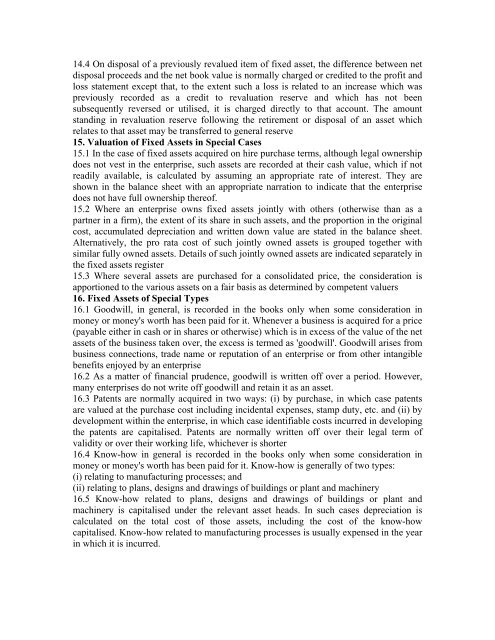Accounting Standards 1-29 - Seth & Associates
Accounting Standards 1-29 - Seth & Associates
Accounting Standards 1-29 - Seth & Associates
Create successful ePaper yourself
Turn your PDF publications into a flip-book with our unique Google optimized e-Paper software.
14.4 On disposal of a previously revalued item of fixed asset, the difference between net<br />
disposal proceeds and the net book value is normally charged or credited to the profit and<br />
loss statement except that, to the extent such a loss is related to an increase which was<br />
previously recorded as a credit to revaluation reserve and which has not been<br />
subsequently reversed or utilised, it is charged directly to that account. The amount<br />
standing in revaluation reserve following the retirement or disposal of an asset which<br />
relates to that asset may be transferred to general reserve<br />
15. Valuation of Fixed Assets in Special Cases<br />
15.1 In the case of fixed assets acquired on hire purchase terms, although legal ownership<br />
does not vest in the enterprise, such assets are recorded at their cash value, which if not<br />
readily available, is calculated by assuming an appropriate rate of interest. They are<br />
shown in the balance sheet with an appropriate narration to indicate that the enterprise<br />
does not have full ownership thereof.<br />
15.2 Where an enterprise owns fixed assets jointly with others (otherwise than as a<br />
partner in a firm), the extent of its share in such assets, and the proportion in the original<br />
cost, accumulated depreciation and written down value are stated in the balance sheet.<br />
Alternatively, the pro rata cost of such jointly owned assets is grouped together with<br />
similar fully owned assets. Details of such jointly owned assets are indicated separately in<br />
the fixed assets register<br />
15.3 Where several assets are purchased for a consolidated price, the consideration is<br />
apportioned to the various assets on a fair basis as determined by competent valuers<br />
16. Fixed Assets of Special Types<br />
16.1 Goodwill, in general, is recorded in the books only when some consideration in<br />
money or money's worth has been paid for it. Whenever a business is acquired for a price<br />
(payable either in cash or in shares or otherwise) which is in excess of the value of the net<br />
assets of the business taken over, the excess is termed as 'goodwill'. Goodwill arises from<br />
business connections, trade name or reputation of an enterprise or from other intangible<br />
benefits enjoyed by an enterprise<br />
16.2 As a matter of financial prudence, goodwill is written off over a period. However,<br />
many enterprises do not write off goodwill and retain it as an asset.<br />
16.3 Patents are normally acquired in two ways: (i) by purchase, in which case patents<br />
are valued at the purchase cost including incidental expenses, stamp duty, etc. and (ii) by<br />
development within the enterprise, in which case identifiable costs incurred in developing<br />
the patents are capitalised. Patents are normally written off over their legal term of<br />
validity or over their working life, whichever is shorter<br />
16.4 Know-how in general is recorded in the books only when some consideration in<br />
money or money's worth has been paid for it. Know-how is generally of two types:<br />
(i) relating to manufacturing processes; and<br />
(ii) relating to plans, designs and drawings of buildings or plant and machinery<br />
16.5 Know-how related to plans, designs and drawings of buildings or plant and<br />
machinery is capitalised under the relevant asset heads. In such cases depreciation is<br />
calculated on the total cost of those assets, including the cost of the know-how<br />
capitalised. Know-how related to manufacturing processes is usually expensed in the year<br />
in which it is incurred.




